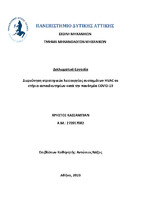| dc.contributor.advisor | Νάζος, Αντώνιος | |
| dc.contributor.author | Κασσαμπιάν, Χρήστος | |
| dc.date.accessioned | 2023-10-26T11:36:50Z | |
| dc.date.available | 2023-10-26T11:36:50Z | |
| dc.date.issued | 2023-10-10 | |
| dc.identifier.uri | https://polynoe.lib.uniwa.gr/xmlui/handle/11400/5496 | |
| dc.identifier.uri | http://dx.doi.org/10.26265/polynoe-5333 | |
| dc.description.abstract | Στην εργασία αυτή θα μελετηθεί και θα διερευνηθεί η συγκέντρωση του ιού σε εσωτερικούς χώρους και θα εξετασθούν δύο στρατηγικές μείωσης του λειτουργικού κόστους ενός συστήματος HVAC : (1) για παροχή 100% εξωτερικού αέρα στο κτίριο και (2) για χρήση διαφορετικών φίλτρων HVAC, συμπεριλαμβανομένου του MERV 10, MERV 13 και φίλτρα HEPA. Αυτές οι στρατηγικές θα εφαρμοστούν σε ένα υποθετικό κτίριο εκπαίδευσης που βρίσκεται σε ζώνες με ψυχρό και θερμό κλίμα. Το Κεφάλαιο 1 αναφέρεται στην εισαγωγή της Διπλωματικής εργασίας, όπου παρουσιάζονται τα εισαγωγικά στοιχεία σε συνδυασμό με τον σκοπό της Διπλωματικής εργασίας και με τα ερευνητικά ερωτήματα. Τα Κεφάλαια 2 έως 4 αναλύουν την βιβλιογραφική ανασκόπηση και την τρέχουσα τεχνολογική στάθμιση που αφορούν τα συστήματα HVAC και την μετάδοση του COVID-19 σε εσωτερικούς χώρους. Το Κεφάλαιο 5 περιγράφει τα στάδια της μεθοδολογίας για την διερεύνηση της συγκέντρωσης του ιού στο υποθετικό κτήριο εκπαίδευσης και του λειτουργικού κόστους για κάθε σύστημα HVAC του προβλήματος. Το κεφάλαιο 6 διεξάγει των σχολιασμό των αποτελεσμάτων έπειτα από την επίλυση των βημάτων της μεθοδολογικής προσέγγισης. Το Κεφάλαιο 7 συγκεντρώνει τα συμπεράσματα της ολοκληρωτικής μελέτης, επιλέγεται ποια στρατηγική λειτουργίας συστημάτων HVAC είναι η βέλτιστη για την αξιοποίησή στην μονάδα του προβλήματος και αναφέρονται ιδέες για μελλοντική χρήση της εργασίας σε παρόμοια ζητήματα. | el |
| dc.format.extent | 97 | el |
| dc.language.iso | el | el |
| dc.publisher | Πανεπιστήμιο Δυτικής Αττικής | el |
| dc.rights | Αναφορά Δημιουργού - Μη Εμπορική Χρήση - Παρόμοια Διανομή 4.0 Διεθνές | * |
| dc.rights | Attribution-NonCommercial-NoDerivatives 4.0 Διεθνές | * |
| dc.rights.uri | http://creativecommons.org/licenses/by-nc-nd/4.0/ | * |
| dc.subject | Συστήματα HVAC | el |
| dc.subject | Covid-19 | el |
| dc.subject | Λειτουργικό κόστος | el |
| dc.subject | Φίλτρα HVAC | el |
| dc.title | Διερεύνηση στρατηγικών λειτουργίας συστημάτων HVAC σε κτήρια εκπαιδευτηρίων κατά την πανδημία COVID-19 | el |
| dc.title.alternative | Investigation of HVAC system operation strategies for educational buildings during the COVID-19 pandemic | el |
| dc.type | Διπλωματική εργασία | el |
| dc.contributor.committee | Maitos, Antonios | |
| dc.contributor.committee | Zafirakis, Dimitrios | |
| dc.contributor.faculty | Σχολή Μηχανικών | el |
| dc.contributor.department | Τμήμα Μηχανολόγων Μηχανικών | el |
| dc.description.abstracttranslated | This paper will study and investigate the indoor virus concentration and examine two strategies to reduce the operating cost of an HVAC system: (1) providing 100% outdoor air to the building and (2) using different HVAC filters, including MERV 10, MERV 13 and HEPA filters. These strategies will be applied to a hypothetical educational building located in cold and hot climate zones.
Chapter 1 refers to the introduction of the thesis, where the introductory information is presented together with the purpose of the thesis and the research questions. Chapters 2 through 4 discuss the literature review and the state of the art related to HVAC systems and COVID-19 indoor transmission. Chapter 5 describes the steps of the methodology for investigating the virus concentration in the hypothetical educational building and the operational costs for each HVAC system in the problem. Chapter 6 conducts the commentary of the results after solving the steps of the methodological approach. Chapter 7 brings together the conclusions of the comprehensive study, selects which HVAC system operation strategy is optimal for utilization in the problem unit and provides ideas for future use of the work on similar issues. | el |


